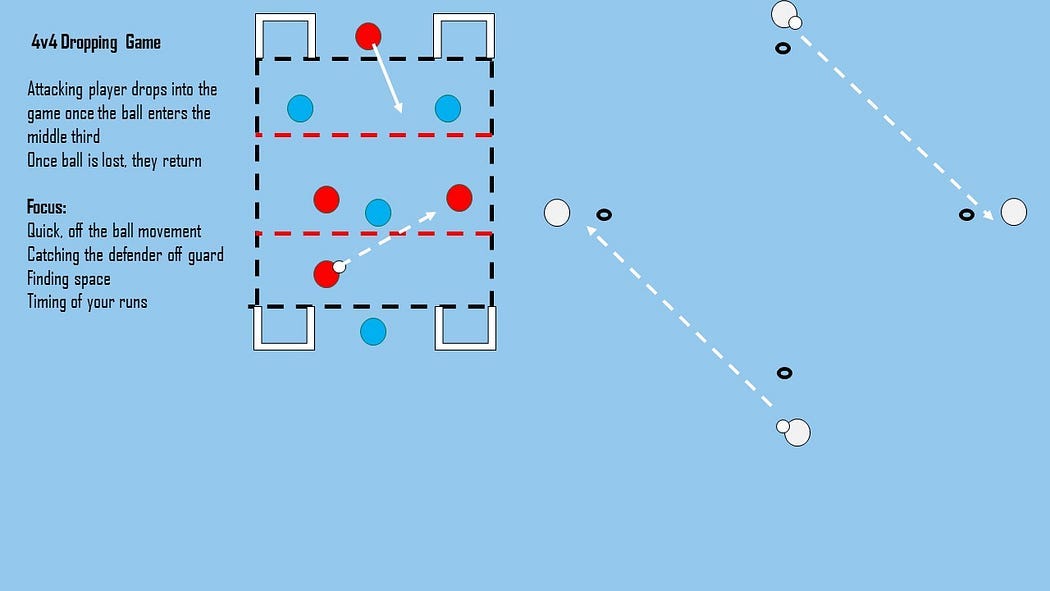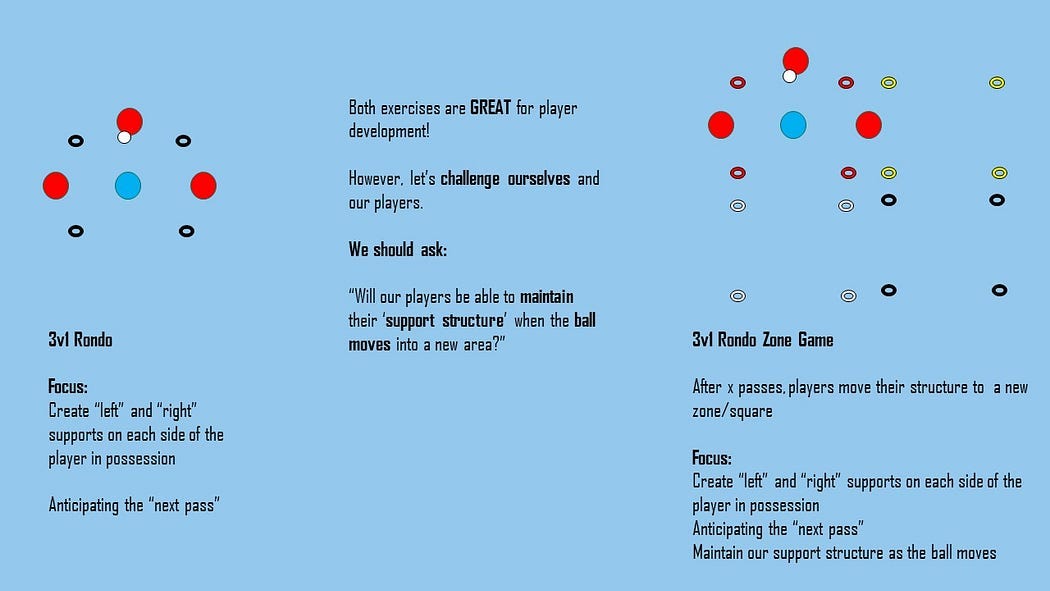Good morning! I want to talk about how to develop creative players.
If you haven’t already, please subscribe!
Enjoy the newsletter!
I don’t know.
Thanks for your time! If you like what you’ve read, consider liking this post and following me on Twitter where I promise what you see there is worse than what you’ll read here.
Follow me on Twitter: https://twitter.com/CamH___
More seriously…
Football players today lack flair. Yell at me all you want, tell me I live in the stone age and that I’m bitter because the players I grew up watching are no longer around. When I ask for a flair player, I want someone like Ronaldinho, Kaka, Stephen Ireland, Eden Hazard, etc.
I want a player with the courage and ability to manipulate the ball in an effective but entertaining way. Football is about entertainment first. Having said that, ball manipulation is not all about tricks, flicks and back heels (although those help). I want to see more players who have a varied skill set.
Why do so many players look the same or play the same? Football has required various player profiles capable of playing different roles, but as the years go on we are seeing less of this variety, and just certain players who work really well in a certain system.
The issue? Football is looking the same more often than not. The difference between top, top teams is perhaps some nuance that caters to certain world class players. This gives football fans the idea that this is how football is played and, as a consequence, is how it is trained at youth levels.
Don’t get me wrong, I love a good possession based system as much as the next fan, but should it come at the sacrifice of player creativity, like we see today? I don’t think so. I believe creative players can succeed in possession based systems, but that’s a conversation for a different day.
Here’s how we’re going to develop more creative players:
Make them two footed
Play players in different roles
Multiple directions in training games that should create chaos
Make them two footed
Football is much easier when you use both feet.
I am determined to make sure that every player I work with is two footed. This is something I have never stopped doing at youth level. It’s so simple to train players to be two footed, so why do so many coaches neglect it?
I don’t have a five star weak foot. I barely have a three star strong foot, but that doesn’t mean I can’t make my players adept at using both feet.
Here’s how I might organize opportunities for players to work on their weak foot in training:
With 12 players I can play a 4v4 themed small-sided game while the four remaining players are off to the side, in a desired shape at a desired size, passing the ball with their weaker foot. I may give a group two balls if I want to increase the speed they pass and receive the ball, like I have above.
I also consider this time “rest” due to how low intensity it is.
After a certain amount of minutes I can swap out the losing team for the “resting” team so that the losing team has time to recover while also getting in quality reps with their weaker foot.
This ensures that everyone gets a good amount of small-sided game time as well as time to work on technique in an unopposed environment.
Making players two footed is simple, coaches just need to make time for it and make the training intentional.
When players are two footed they become more unpredictable. For example, wingers don’t have to be one of: a wide winger or inverted winger, they can become both depending on the state of the game, making them a useful tool for the coach.
Now imagine a team of 11 players like this.
Fluid football with players swapping positions seamlessly is now even easier because the players don’t need to worry about which angle they need to pass/receive the ball based on the foot they use because they can use both feet.
I am a total football fan. I think it’s the best way to develop players and the most entertaining way to play and watch football. I also think that two footed players are integral to total football perfection, so I strive to make players that can fit this mold.
Put players in different roles
Many youth coaches will put a player in a specific position and leave the player in that position from the moment they arrive at the club/academy to the moment they leave at 18. I don’t need to spend much time explaining why a nine year old shouldn’t “master” any position — they’re nine. They need to master football.
I typically rotate players through various positions every three to four weeks at ages under 13, and every three months at older age groups, but it changes depending on the group.
So, for three weeks a U12 player I work with may play as a CB/FB, then after three weeks I move them into any of the midfield roles, then into the forward positions.
I will move players into specific roles, like a “destroyer” midfielder, a ball-playing deep midfielder (#6) or a creator (#10) when working with older age groups, U15 and older.
This has been very successful for me (so far) because it gives youth players a chance to work on different skill sets before we move them into the position we think they would be best at when they’re older.
Sometimes it doesn’t always make sense — like playing a small, pacey, tricky type of player who usually thrives in attacking 1v1 situations, as a holding midfielder or fullback. However there are benefits.
A good ball-playing holding midfielder, in my opinion, has an excellent passing range. So why is this limited to just the holding midfielder? What if we could teach a winger to have an excellent passing range? Where else on the pitch could they play if their passing was immaculate?
This is just one example. I’m certain that the more you think about it, you will find more benefits and ways to develop a player.
Giving a player more skills helps them become more creative because it gives them more answers to the questions football asks of them.
I will concede that if you are heavily dependent on results to keep you in a job, don’t try this. It can be costly at times. If you’re dependent on results as a youth coach however, perhaps seek greener pastures.
Multiple directions in training games that should create chaos
We need to overwhelm players with choices to give them more opportunities to make “game-like decisions”. Football can be simple, but it’s hard to find the right solution in an actual football match.
As football gets physically faster to play, it means decisions need to be made faster. A good way to get players comfortable with making different decisions faster is to put them in small-sided games with several directions and opportunities to “score” or “succeed”.
In addition to the speed of football changing, so does the number of transitions we’re seeing in games and their importance. Creating several transitional moments in training gives players the chance to learn how to use their tools to counter-attack or counter-press.
Take a look below for an example of how I may introduce different directions to my players:
Rondos are great. Nobody will deny that. Coaching points can be made that reflect your game model or development plan for what seems like every style or system.
I don’t want to reinvent the wheel. However, adding different zones or areas that our players can go to from the rondo can show us if/how they maintain a shape and, more specifically, if they’re maintaining a shape we are trying to work on, like the idea above.
Now, an example of using multiple directions that welcome transitional moments can be seen below.
The ball can and will enter the game from any direction. It can and will enter the game from behind or beside a player, for example. How often do we train players to react to these types of moments?
It’s in chaotic directional games like this we can see how our players react to intense transitional moments and what solutions they can come up with by making them two footed and playing them in different roles.
A striker or winger will need to react to a transitional moment in the final third that can happen from any direction that isn’t in front of them. How will they react and how can they solve the problem football is asking of them?
Conclusion
There is no golden method to making players who are more creative. I like these solutions because I believe in giving players as many tools as possible and letting them solve problems. Footballers are smarter than we give them credit for.
I’ve also seen these solutions work with my own eyes. I’ve seen mentors and colleagues try these ideas and I’ve done it myself.
It isn’t a “one size fits all” solution because I don’t know the constraints all coaches work within.
However, I implore you to try some of these ideas for yourselves and see what you come up with. If you develop the next Kevin de Bruyne, Ronaldinho, Shaun Wright-Phillips etc be sure to show this article to the media.
Thanks for reading this week! Please “like” this post by clicking the heart icon above. Substack will show this to more people if you like it, which means more paid members, which means more paid writers for this publication!
Once you’ve liked this, share this newsletter with a friend or every single person you have ever met.








